Artificial Intelligence Statistics By Dependent Industries Processes, Perceptions, Adoption Rate, AI Capabilities, Obstructions to Adopt AI and Departments
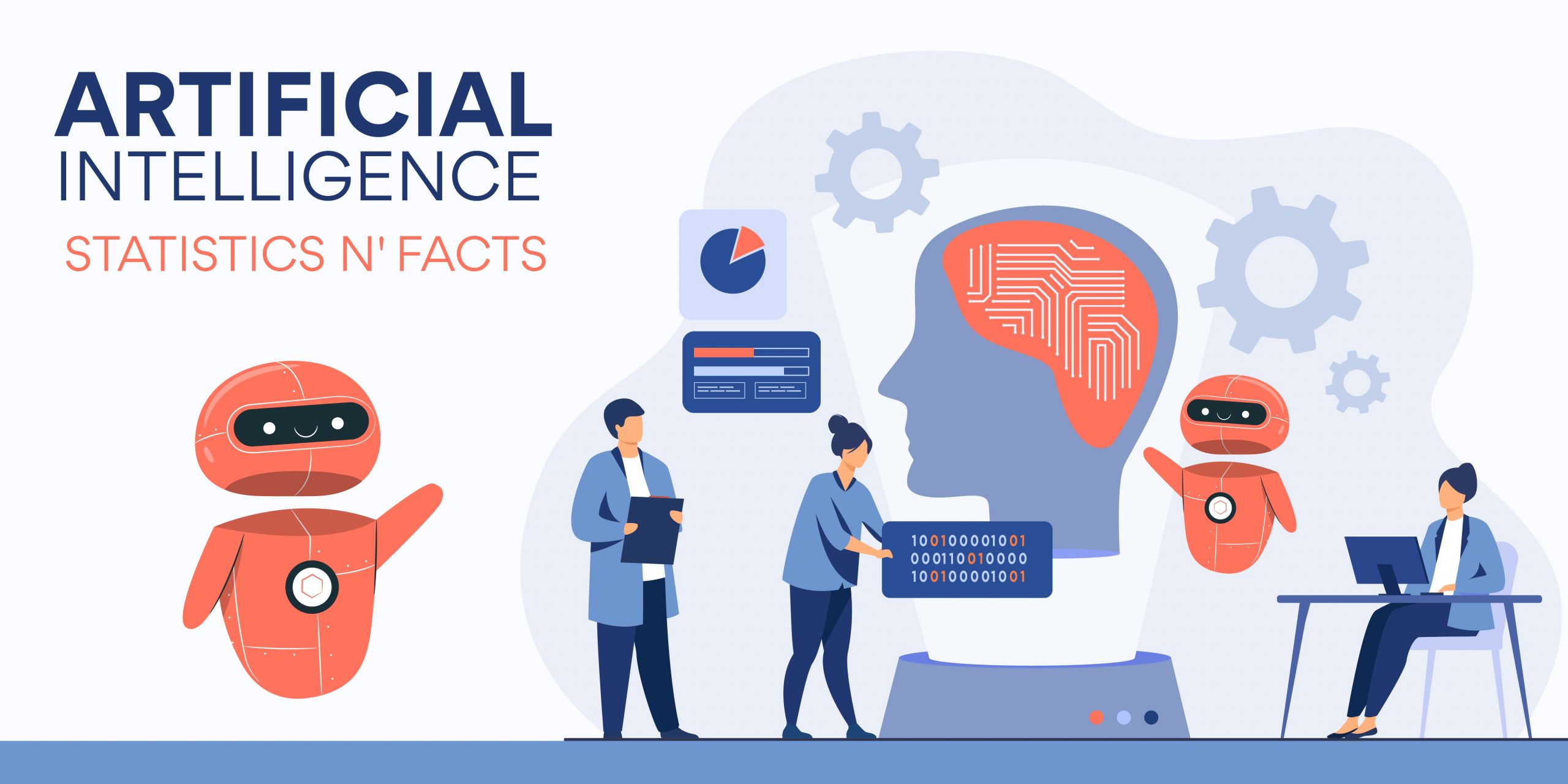
Page Contents
- Introduction
- Editor’s Choice
- What is Artificial Intelligence?
- Features of Artificial Intelligence
- AI Products
- AI Services
- General Artificial Intelligence Statistics
- AI Statistics By Market.us
- By Dependent Industries Processes
- By Perceptions
- By Adoption Rate
- By Industry
- By Country
- By AI Capabilities
- By Cloud Environment
- By Voice Assistance
- By Obtructions to Adopt AI
- By Departments
- When Image Generation Goes Wrong
- Conclusion
Introduction
Artificial Intelligence Statistics: Imagine waking up to a Robot staring at your face and serving you a cup of morning coffee. At first, it will look comfortable, but what if in the coming years, these robots entirely replace humans and take over the world? Scary isn’t it? Just look at these Artificial Intelligence Statistics and see at what rate companies are adopting this technology. As of 2023, the global AI market is valued at $136.6 billion and is expected to grow at a CAGR of 37.3% by 2030.No wonder why, the robot was serving you a cup of coffee, this technology is just in the initial phase. In years to come we will experience what advanced means.
Editor’s Choice
- Almost 1 in 5 companies state difficulties in the integration of data across any cloud, managing disparate data sources and formats, and data governance.
- According to Artificial Intelligence Statistics, 92% of voice assistance users search for information online, while 75% use it to set a reminder.
- It is reported that more than 80% of marketers will merge their online marketing activities with AI in the coming years.
- By 2028, Artificial Intelligence statistics in Marketing predict that the global market revenue will reach $107 billion.
- The highest number of employees working in departments where AI is deployed are IT professionals (54%), Data Engineers (35%) Developers, and data scientists (29%).
- United States of America is the leading country to invest in AI technology resulting in $47.4 billion as of 2022.
- The majority of the consumers state that AI and machine learning are Game Changers resulting in 71%.
- As of 2023, the Marketing and Advertising industry has the highest adoption rate resulting in 37%, followed by Technology and Consulting at 35% and 30% respective adoption rate.
- 4% of small-scale businesses use artificial intelligence for content creation such as ad copy, blog posts, social media captions, etc.
- 31% of the companies in the United States of America stated that AI and machine learning techniques helped to gain more insights into trend insights and audience preferences.
What is Artificial Intelligence?
Artificial Intelligence (AI) is the ability of machines to perform human-like tasks associated with human intelligence. In such cases, once input is given, machines perform the activities on their own just like humans would do. AI is a vast and complex term to some extent. Today, Artificial Intelligence has grown in leaps and bounds that we, humans, are scared that in coming years, machines will dominate the human world. AI offers great aid in artificial neural networks, mathematical optimization, statistics, probability and economics, and other fields such as Neuroscience, Philosophy, Linguistics, psychology, and much more. Some of the AI tools are Voice Assistants (Siri and Alexa), Creative Tools (ChatGPT, Bing), Self Driving Cars (Tesla, Waymo), and Streaming Services (Amazon, YouTube, and Netflix).
Features of Artificial Intelligence
- Artificial intelligence can act as a human
- It can easily solve complex problems related to almost anything
- It has an abundance of knowledge
- It can teach users anything in the world
- AI has the ability to transform tedious tasks into automated mode
- Artificial Intelligence can play games, and create photos and movies.
- It has the ability to transfer text into images and vice versa.
AI Products
- Smartphone mobiles
- Smart Cars
- Wearables
- Robotic Vaccum Cleaners
- Security and Surveillance
- Space Exploration Devices
- Smart home devices
- Robots
- Other essential products related to various industries such as Agriculture, Healthcare, Military, Aerospace, Robotics, Education, Finance, etc.
AI Services
- Music and Video Streaming
- Smart Home
- Chatbots
- e-Payments
- Gaming
- e-Commerce
- Text Editors and auto-correctors
- Digital Assistants
- Cloud Computing
- Overall Digitalization
General Artificial Intelligence Statistics
- As of today, 35% of the companies are the globe are using artificial intelligence.
- According to reports, 66% of businesses are planning or using AI for their sustainability goals.
- By 2028, Artificial Intelligence statistics in Marketing predict that the global market revenue will reach $107 billion.
- 90% of the marketers collectively in 35 countries used AI to automate their customer interactions.
- The global ChatBot market is expected to hit $1.25 billion by 2025.
- It is reported that more than 80% of marketers will merge their online marketing activities with AI in the coming years.
- 55% of the companies in the United States of America agreed that integrating ChatBots with customer service is helping to generate new leads.
- Around 50% of the consumers in the United States of America believe that generative AI or Photoshop should not be used for commercial purposes.
- 47% of the companies in the selected countries such as India, Canada, the United States of America, and the United Kingdom trust in Artificial Intelligence integration with Ad targeting.
- Artificial intelligence Statistics state that by 2030, the worldwide AI market will reach $1.59 trillion at a CAGR of 37%.
- With the help of AI, the expected growth in GDP will be 26% by 2030.
- 61% of the employees state that AI aids in improving productivity, with 40% expected employee productivity rate.
- 87% of companies around the world believe that Artificial Intelligence Technology will help them with a competitive edge.
- 10% of marketers are not ready to use AI in their marketing activities.
- 31% of the companies in the United States of America stated that AI and machine learning techniques helped to gain more insights into trend insights and audience preferences.
- 50% of marketers are concerned about data privacy and ethics implemented with artificial intelligence.
- Top-performing companies are 2 times more likely to implement AI for marketing.
- Moreover, 70% of top-performing marketers have a defined AI strategy.
- Over the last 5 years, Artificial Intelligence has grown by 300% around the world.
- Majority of the B2B marketers use Chatbots to understand their audience in a better way resulting in 57% while 55% use it for generating new leads and 43% use it for educating prospective customers.
- As of 2022, only 28% of the people entirely trust AI.
- United States of America is the leading country to invest in AI technology resulting in $47.4 billion as of 2022.
- As compared to American consumers, citizens of China are more positively thinking about AI services and products.
- Almost 1 in 5 companies state difficulties in the integration of data across any cloud, managing disparate data sources and formats, and data governance.
- By the end of 2023, it is estimated that around 8 billion voice assistants will come into effect.
- The advancement of AI will reduce 85 million jobs, however, simultaneously 97 million jobs will be created.
- 67% of American citizens say that self-driving cars are safer than regular cars.
- By 2025, the worldwide wearable AI market is expected to reach $180 billion.
- Around 64% of consumers are ready to submit their personal data to AI to improve the overall experience.
- By 2025, AI Statistics state that 100 million people will work in the AI industry.
- 80% of the HR workforce reported positive attitudes towards AI technology related to the HR industry.
- The autonomous vehicle industry is expected to reach $667.7 billion by 2026.
- In 2022, around 57% of B2B marketers used Chatbots for their demand generation programs to understand their audience.
- Around the world, 77% of devices are already using at least one AI feature.
- As of 2022, 92.1% of the companies saw positive results after implementing Artificial intelligence technology in their business processes.
- As of 2022, the annual report by Standford University stated that 2.05% of the job postings made in the United States of America required some kind of AI-related skills.
- According to experts, 60% of the currently employed workforce in AI-related jobs didn’t even exist 80 years ago.
- As of 2023, machine learning grew by 48% in the automotive sector around the world.
- Every Google processes more than 6.9 billion search queries related to global AI technologies.
- 9% of businesses around the world have been replaced by AI tools.
- It is estimated that by 2030, intelligent robots will replace 30% of the global workforce.
- Furthermore, estimates show that 20 million jobs related to the manufacturing industry could be lost because of automation by 2030.
AI Statistics By Market.us
- The global Artificial Intelligence market is expected to reach approximately USD 2,745 billion by 2033, with a steady Compound Annual Growth Rate (CAGR) of 36.8%.
In 2023, the AI software segment dominated the market, holding over 39.3% of the market share, playing a crucial role in various applications such as natural language processing and machine learning. - Deep learning, a subset of machine learning, accounted for more than 35.0% of the AI market share in 2022, showcasing its advanced capabilities in handling large and complex datasets.
The Advertising & Media segment held a dominant position in 2023, contributing to over 21% of the AI market share, driven by personalized marketing strategies and content optimization. - North America led the AI market in 2023, capturing over 51.1% of the global market share, attributed to its advanced technological infrastructure and high adoption rates across multiple sectors.
- In 2023, the software segment was the dominant market position holder in the AI market, accounting for more than 39.3% of the market share, primarily due to its integral role in driving AI technologies' functionality and advancement.
- Deep learning, a segment of machine learning, held a significant market position in 2022, capturing over 35.0% of the AI market share, thanks to its adeptness in handling vast and intricate datasets.
- In 2023, the Advertising & Media segment topped the market position, contributing over 21% of the AI market share, as AI technologies revolutionized content creation, optimization, and delivery.
- North America maintained its lead in the AI market, securing over 51.1% of the global market share, owing to its advanced technological infrastructure facilitating AI adoption across various sectors.
- The size of the Artificial Intelligence market was estimated USD 177 billion in 2023, with a projected CAGR of 36.8%.
- Key players in the AI market include Advanced Micro Devices, AiCure, IBM, Oracle Corporation, Amazon Web Services, Cisco Systems Inc., Arm Limited, Atomwise, Inc., Ayasdi AI LLC, Baidu, Inc., Clarifai, Inc, HyperVerge, Inc., Intel Corporation, Microsoft, Google, NVIDIA Corporation, among others.
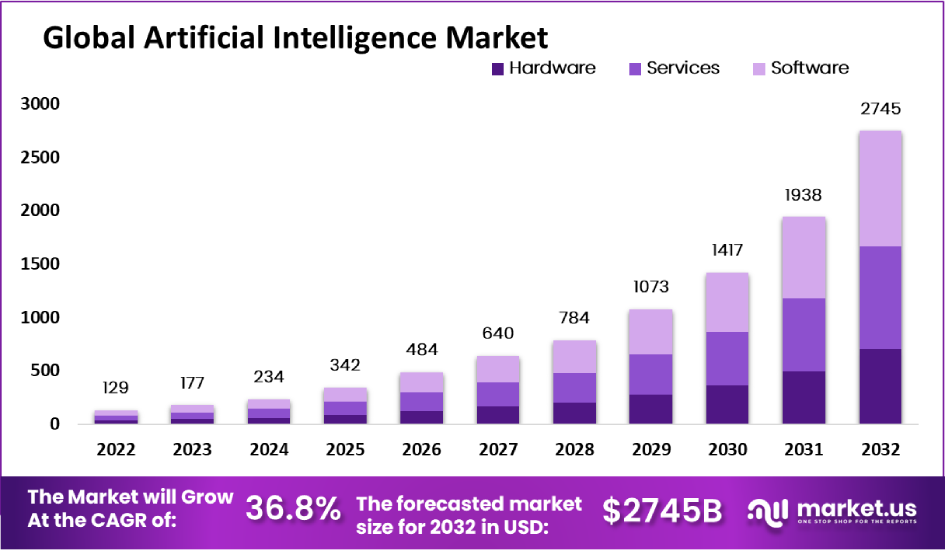
By Dependent Industries Processes
 (Source: financesonline.com)
(Source: financesonline.com)
As of 2023, the top three industry processes that are heavily dependent on Artificial Intelligence are Vehicular Detection and Avoidance ($8.9 billion market value), Static Image Recognition ($7.6 billion market value), and Patient Data Processing ($7.2 billion market value) with the lowest ranked processes Conversion of paperwork to digital data ($5.4 billion market value), Intelligent HR systems ($5.3 billion market value) and Medical Image Analysis ($5.1 billion).
By Perceptions
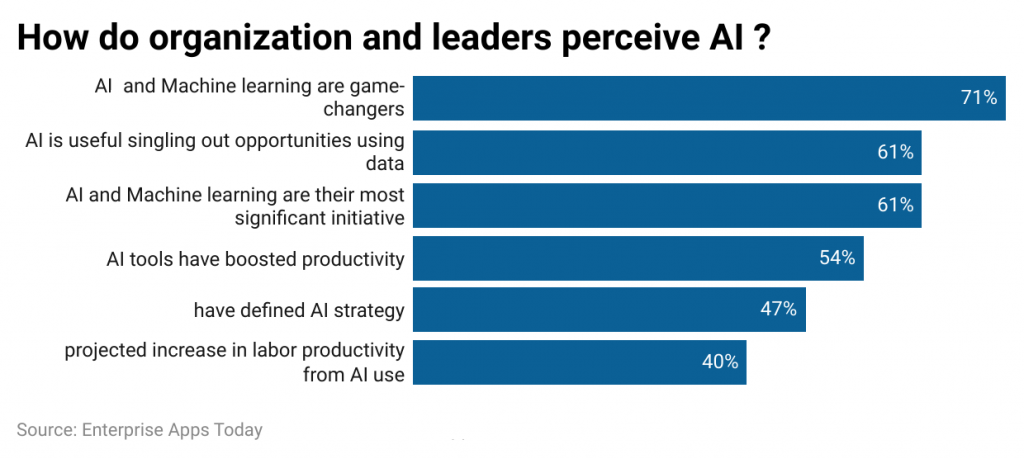
(Source: financesonline.com)
The majority of the consumers state that AI and machine learning are Game Changers resulting in 71%. Other agrees that the technology is useful and significant as well as helpful in boosting productivity. There are only 40% of leaders say using AI provides a projected increase in labor productivity.
By Adoption Rate
By Industry
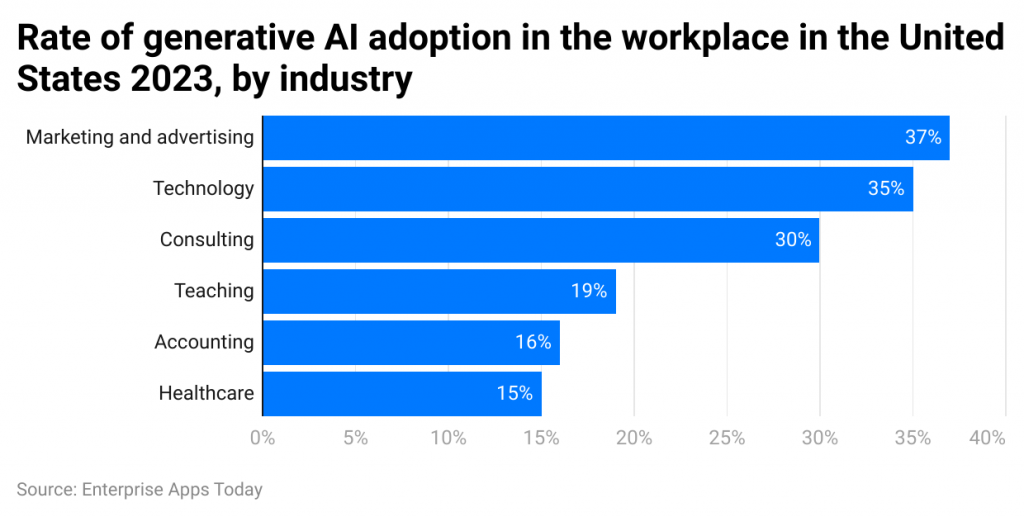 (Source: statista.com)
(Source: statista.com)
As of 2023, the Marketing and Advertising industry has the highest adoption rate resulting in 37%, followed by Technology and Consulting at 35% and 30% respective adoption rate. The healthcare industry has the lowest adoption rate as compared to other industries with only 15%.
By Country
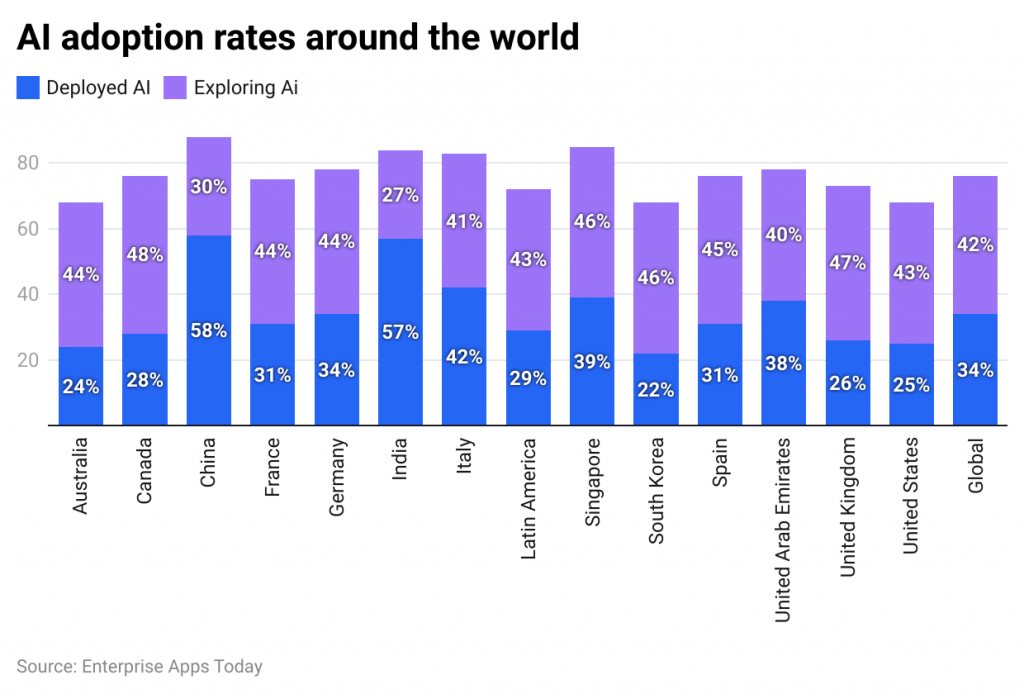 (Source: ibm.com)
(Source: ibm.com)
As of 2022, the global comparison of AI adoption rates states that China (58%), India (57%), and Italy (42%) have the highest rates of AI deployment, while Canada (48%), the United Kingdom (47%), and Singapore (46%) have the highest rates in exploring AI. The global AI deployment rate in 2022 stood at 34% while the AI exploration rate was 42%.
By AI Capabilities
- 4% of small-scale businesses use artificial intelligence for content creation such as ad copy, blog posts, social media captions, etc.
- 50% of companies around the world use at least one AI function for their business process.
AI Market Growth and Investment:
- Global AI spending is projected to reach $154 billion in 2023, with a 26.9% increase from 2022, and is expected to surpass $300 billion by 2026.
- The global AI market value is anticipated to hit $1.81 trillion by 2030.
- AI's total contribution to the global economy might reach $15.7 trillion by 2030.
Adoption and Impact on Jobs:
- About 37% of organizations were using AI in the workplace by 2019.
- AI is expected to eliminate 85 million jobs but create 97 million new ones by 2025, netting an addition of 12 million jobs.
Consumer Perception and Usage:
- More than 3 billion voice assistants were in use by the end of 2019, with 46% of Americans using voice-controlled virtual assistants.
- Only 32.5% of users trust AI-generated search results, yet 98.1% of digital marketers recognize the importance of understanding AI for their jobs.
AI in Industries:
- In the retail sector, AI spending is expected to reach $20.05 billion by 2026.
- The healthcare industry sees 38% of providers using computers as diagnosis assistants.
Ethical and Societal Implications:
- The number of AI incidents and controversies has increased 26 times since 2012, indicating growing concerns over the ethical use of AI.
- Ethical challenges in AI, such as bias and fairness, continue to be major topics of interest among researchers and practitioners.
By Cloud Environment
What Cloud Environments Are Companies Currently Using?
| Sector | % |
|---|---|
| Private cloud | 43% |
| Hybrid cloud or multi-cloud | 32% |
| Public cloud | 13% |
| On-premises | 8% |
(Source: ibm.com)
- AI Technical Performance and Environmental Impact: AI tools continue to surpass benchmarks, indicating a need for more challenging tests. Training big models like GPT-3 incurs significant carbon emissions, highlighting environmental costs.
- AI in Marketing and Business:
- 31% of US companies reported that AI and machine learning have enhanced insights into trends and audience preferences.
- AI has grown by 300% globally over the last five years, with top-performing companies being twice as likely to implement AI in marketing strategies.
- Cloud Environment Adoption by Companies:
- 43% of companies use private cloud, 32% employ hybrid or multi-cloud strategies, 13% are on public cloud, and 8% rely on on-premises environments.
- Cloud Technology Challenges and Opportunities:
- Identifying the right technology is a significant challenge for 47% of SMBs. The pandemic led 52% of SMBs to make incompatible SaaS investments.
- Cloud adoption has enabled 51% of businesses to accelerate time to market, with 54% of global tech and business leaders seeking cloud providers that can increase revenue.
- Future of Cloud Data: An astonishing 200 zettabytes of data are expected to be on the cloud by 2025. Currently, approximately 5 billion people use the cloud, with the number projected to rise significantly by 2030.
By Voice Assistance
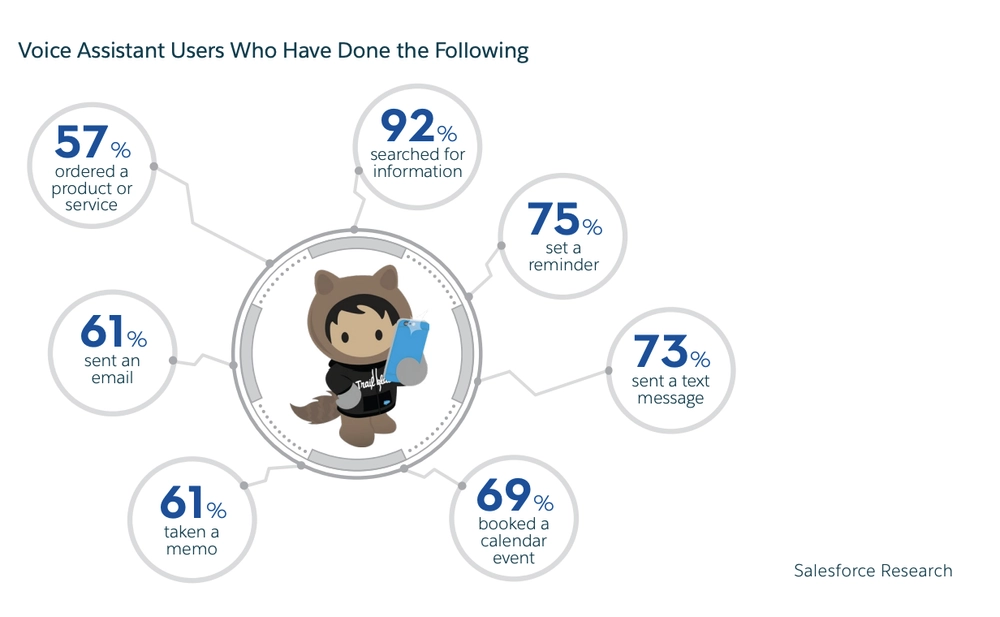 (Source: thesocialshepherd.com)
(Source: thesocialshepherd.com)
According to Artificial Intelligence Statistics, 92% of voice assistance users search for information online, while 75% use it to set a reminder. Other activities followed using Voice Assistance are sending a text message (73%), Booking a calendar event (69%), Writing a Memo and Email (61%), and Ordering a product or service (57%).
Voice Assistant Adoption and Use:
- In the US, 41% of adults use voice search daily.
- The number of voice assistants worldwide is expected to surpass 8.4 billion by 2024.
- Google Assistant now supports over 30,000 home devices globally.
- Approximately 45% of voice assistant users prefer Apple’s Siri for voice searches.
- As of 2023, voice assistant users have reached 125.2 million in number.
Consumer Engagement and Preferences:
- About 72% of US consumers utilize voice assistants for voice searches.
- Around 66% of voice search users employ the technology to check the weather.
- Voice search is predominantly used for setting alarms and reminders by 58% of its users.
- The smart speaker market is projected to reach a value of $30 billion by 2024.
Market Value and Future Projections:
- The voice recognition and speech market is expected to be valued at over $53.94 billion by 2030.
- A significant concern among 41% of digital assistant users is the fear that the technology might be recording them.
SEO and Voice Search:
- Over 80% of Google Assistant voice search results come from the top three search results, indicating a high accuracy rate for Google Assistant results.
Business Productivity and AI:
- 61% of workers report that the adoption of AI in the workplace has boosted productivity, with employees appreciating AI's assistance in tasks, leading to improved collaboration between teams.
Customer Service and Sales:
- AI-powered customer service interactions have seen a 400% increase from 2017 to 2021, with 15% of customer service interactions being fully powered by AI as of 2021.
- Sales departments have also embraced AI, with 21% of sales teams using AI in 2018, a number expected to rise significantly.
Cost Benefits:
- 54% of firms utilizing AI reported seeing cost savings and efficiencies, marking the largest benefit of AI use in businesses.
By Obtructions to Adopt AI
| Limited AI skills, expertise or knowledge | 34% |
| The price is too high | 29% |
| Lack of tools or platforms to develop models |
25% |
| Projects are too complex or difficult to integrate and scale |
24% |
| Too much data complexity | 24% |
(Source: ibm.com)
Key Obstructions to AI Adoption
- Limited AI Skills, Expertise, or Knowledge (34%): A significant barrier, highlighting the crucial need for skilled professionals in the AI domain.
- High Costs (29%): The financial investment required for AI implementation is a major concern for companies, emphasizing the need for cost-effective AI solutions.
- Lack of Tools or Platforms to Develop Models (25%): This underscores the necessity for more accessible and user-friendly AI development platforms.
- Complexity in Integration and Scaling (24%): The difficulty of integrating and scaling AI projects presents a significant hurdle for organizations.
- Data Complexity (24%): Managing and interpreting complex data sets for AI applications remains a challenge.
Market Insights and Adoption Statistics
- The global AI market was valued at USD 136.55 billion in 2022, with expectations for significant growth at a CAGR of 37.3% from 2023 to 2030.
- AI adoption rates by industry show that the Marketing and Advertising industry leads with a 37% adoption rate, followed by Technology and Consulting at 35% and 30% respectively. Healthcare has the lowest adoption rate compared to other industries, with only 15%.
- Globally, China (58%), India (57%), and Italy (42%) boast the highest rates of AI deployment, showcasing the varied pace of AI integration across different regions.
- 42% of businesses are experimenting with AI, and 37% are in the process of creating an AI strategy, highlighting the growing interest and strategic emphasis on AI technologies.
- The Covid-19 crisis accelerated AI adoption for 52% of companies, indicating a rapid pivot towards digital and AI-driven solutions in response to the pandemic.
Future Trends in AI Adoption
- The AI landscape continues to evolve, with future trends pointing towards more integrated use of AI in text, speech, vision, and creative spaces. The development of explainable and adaptive AI is expected to prioritize ethical considerations and enhance consumer experiences. Moreover, the expansion of edge AI signifies a move towards decentralized AI applications
By Departments
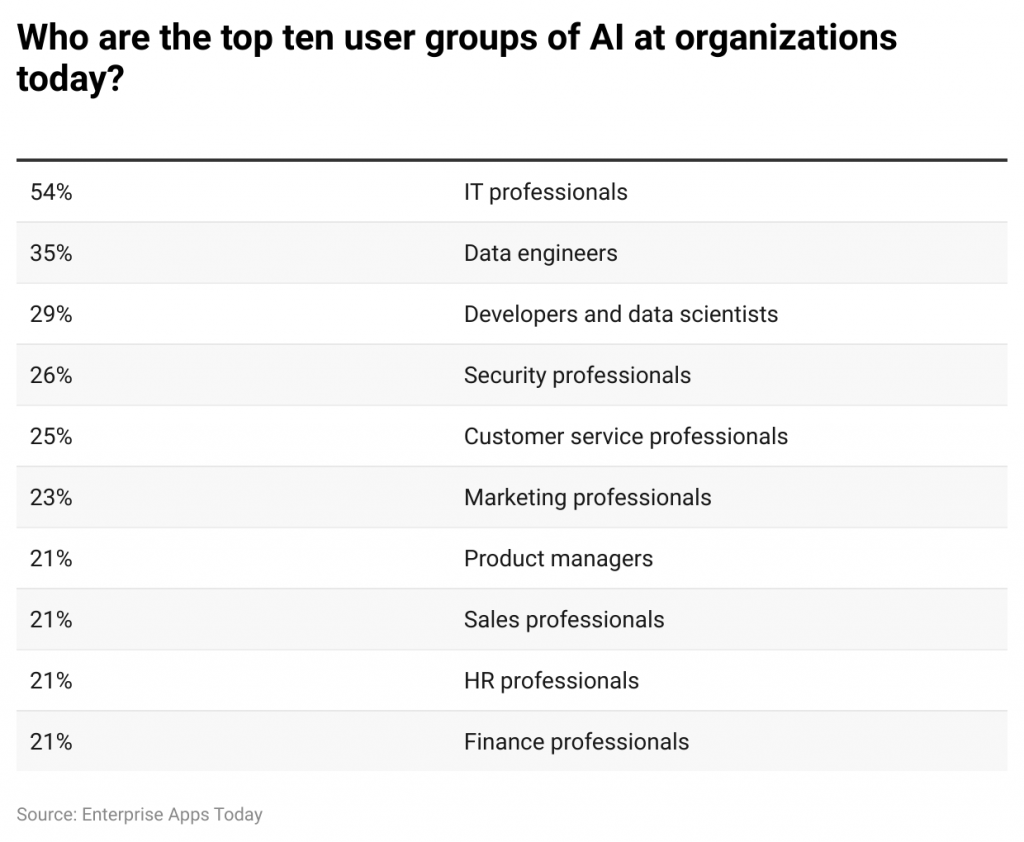 (Source: ibm.com)
(Source: ibm.com)
The highest number of employees working in departments where AI is deployed are IT professionals (54%), Data Engineers (35%) Developers, and data scientists (29%). Other departments that tail the list are Security Professionals (25%), Customer Service Professionals (25%), Marketing Professionals (23%), Product Managers, Sales Professionals, HR Professionals, and Finance Professionals (21%).
When Image Generation Goes Wrong
#1.

(Source: boredpanda.com)
#2.

(Source: boredpanda.com)
#3.

(Source: boredpanda.com)
#4.

(Source: boredpanda.com)
#5.

(Source: boredpanda.com)
Conclusion
Just as we are entered 2024, the newly developed AI is already in demand for its AI-generated photos and videos. Our social media is flowing with AI-generated people. Using some tools and social media, users are creating a percentage of AI-based social media accounts. For example, there’s an Instagram account that is totally made from virtual reality but looks human-like, and users are enjoying it. It is not only social media, AI has stepped into other industries as well and helping human with their stressful work. According to Artificial Intelligence Statistics, the adoption rate at which everyone is integrating with AI will soon be replaced by 100%.
Sources
FAQ.
AI has proved to be the most effective technology because it can replace humans’ tedious work, solve complex problems, provide answers to almost anything, be a human assistant, and perform activities as instructed by the user.
In the coming years, using AI’s algorithms, and the ability to analyze large amounts of data structure, and data sets, and with some mathematical calculations, studying wormholes and black holes will become easy thus, thus making it possible to travel in time.
AI is making it possible to solve the mysteries of everything. It can give answers from the cosmos to the human body. It can also solve much more complex mathematical questions that help to understand the overall facts in the world. In simple words, it is making the human life easier.
It is possible that by the time we step into the most advanced technology, we might no longer be able to control the machines and some unfortunate events will take place. But we still have time to prevent something like this from happening. It is in our own hands to where, how, how much, and when AI-like technology should be used.
It is in our own hands to control this technology. If you are letting the advanced technology access your personal information, and be a part of your daily routine, then you must control your habits before it's too late.

Barry is a lover of everything technology. Figuring out how the software works and creating content to shed more light on the value it offers users is his favorite pastime. When not evaluating apps or programs, he's busy trying out new healthy recipes, doing yoga, meditating, or taking nature walks with his little one.